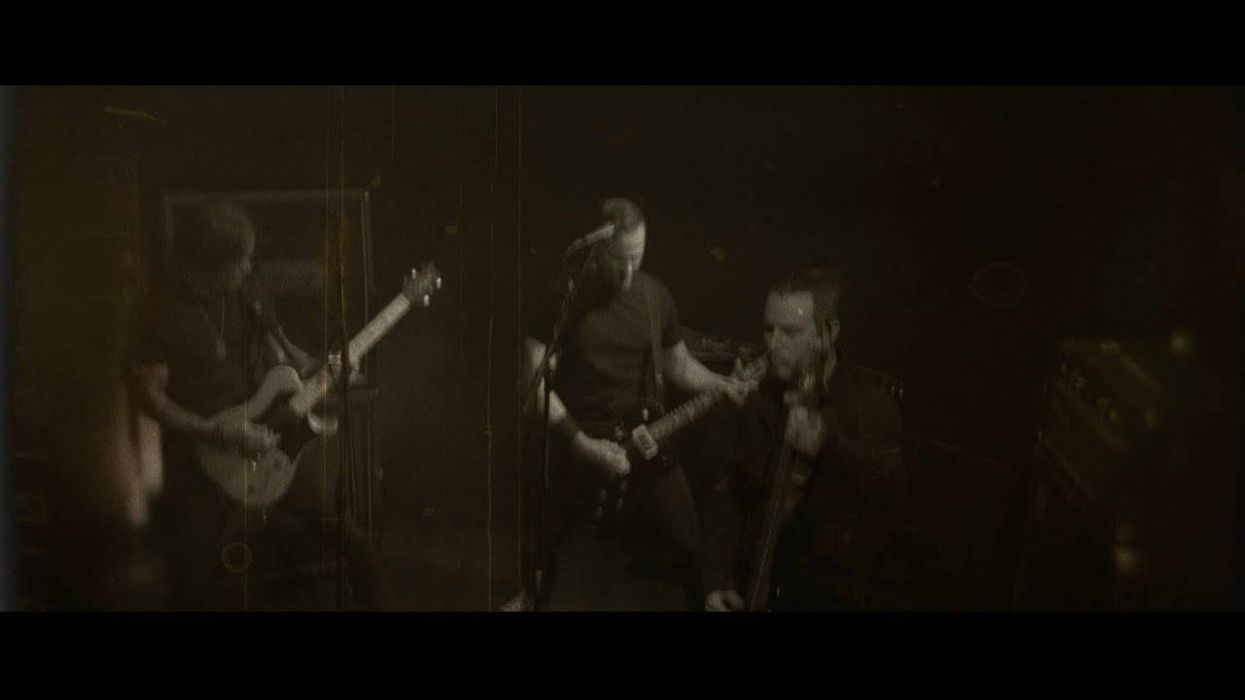When we look at the architecture of a
chord form, we see everything that’s
needed to naturally unfold an improvised
melody. There are two distinctly different
ways to expand the chord form—our skeletal
melody—into linear improvisations.
The standard way, and this is the approach that’s most often taught, is to use horizontal scale forms (this also includes modal systems). An alternative approach comes through using arpeggios. This is a vertical approach, which is evident when you look at the chord displayed graphically.
Beginning with a diminished chord on the lowest adjacent string group, the following transformations unfold, as shown in Fig. 1. [Note: To streamline the music notation, we’re spelling F dim using B and D, which are enharmonic equivalents for Cb and Ebb, the b5 and bb7 of this diminished chord.] Pay attention to the two half-step shifts that occur between these three chords. First, F drops to E, making the F dim to E7 chord change. Second, G# drops to G to create the E7 to Em7 shift.

The following examples contain two separate chord forms that compatibly reveal the same topic—E minor. The first is based on Em7—the same voicing we created a moment ago—and is shown in Fig. 2. The line in this example emerges from this Em7 chord and contains all four of its tones. The second is based off an inversion of Gmaj7 (technically, we’re viewing it as a rootless Em9) and is shown in Fig. 3. Note that the arpeggios found in Fig. 2 and Fig. 3 are notated in red to indicate their skeletal frameworks. The Em7 arpeggio in Fig. 2 is spread in non-adjacent order with intermediate tones set in between and around the arpeggio itself. In Fig. 3, the Gmaj7 arpeggio appears as adjacent tones.
Download Example Audio...


When combined with fluency, these dual patterns become unified as one, and although constructed from vertical tangents, they now appear horizontal in context, as seen in Fig. 4. In this example, we first encounter the vertical Em11 (created by combining Em7 and Gmaj7), followed by a horizontal expression of this harmony.
Download Example Audio...

Keep in mind that forms of this nature are commonly transcribed and analyzed as derivatives of scale and modal concepts, but in reality, they were not constructed in those ways. As we saw in last month’s lesson (“Augmented and Diminished Forms,” March 2011 PG), augmented and diminished structures, as parental forms, automatically position themselves across the guitar fretboard. They appear both vertically and horizontally, along with their alterations that produce dominant 7th, major 7th, and minor 7th forms.
Once you explore these shapes you can also see their related inversions develop exponentially across the fretboard, not only as chordal inversions, but as arpeggio-based linear inversions as well. We’ll continue to unfold these expansions in our upcoming lessons.
 Pat Martino
Pat Martino
Since his first recording as a leader in 1967, Pat Martino has constantly pushed the limits of jazz guitar with his flowing technique and powerful, muscular tone. Showing no signs of slowing down, Martino still travels the world performing and giving lectures about his approach to the guitar. Currently, Martino is working on an autobiography and serving as adjunct faculty at the University of the Arts in Philadelphia. For more info, visit patmartino.com.
The standard way, and this is the approach that’s most often taught, is to use horizontal scale forms (this also includes modal systems). An alternative approach comes through using arpeggios. This is a vertical approach, which is evident when you look at the chord displayed graphically.
Beginning with a diminished chord on the lowest adjacent string group, the following transformations unfold, as shown in Fig. 1. [Note: To streamline the music notation, we’re spelling F dim using B and D, which are enharmonic equivalents for Cb and Ebb, the b5 and bb7 of this diminished chord.] Pay attention to the two half-step shifts that occur between these three chords. First, F drops to E, making the F dim to E7 chord change. Second, G# drops to G to create the E7 to Em7 shift.
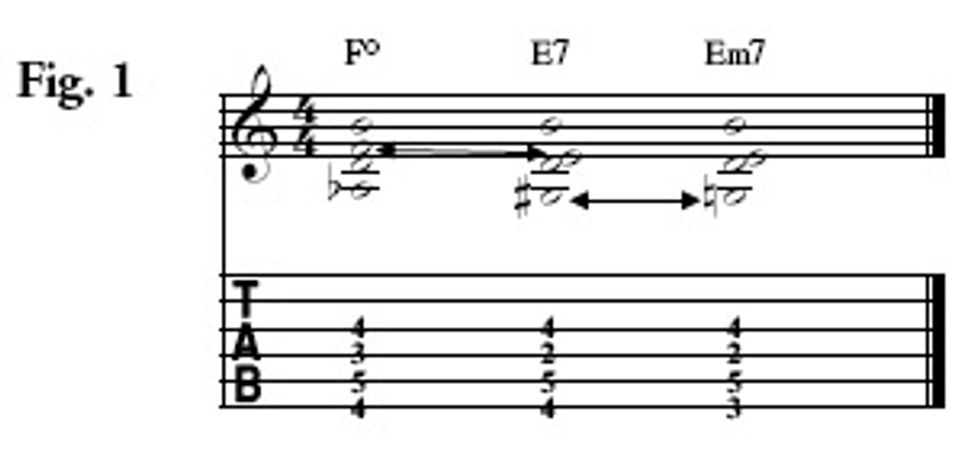
The following examples contain two separate chord forms that compatibly reveal the same topic—E minor. The first is based on Em7—the same voicing we created a moment ago—and is shown in Fig. 2. The line in this example emerges from this Em7 chord and contains all four of its tones. The second is based off an inversion of Gmaj7 (technically, we’re viewing it as a rootless Em9) and is shown in Fig. 3. Note that the arpeggios found in Fig. 2 and Fig. 3 are notated in red to indicate their skeletal frameworks. The Em7 arpeggio in Fig. 2 is spread in non-adjacent order with intermediate tones set in between and around the arpeggio itself. In Fig. 3, the Gmaj7 arpeggio appears as adjacent tones.
Download Example Audio...
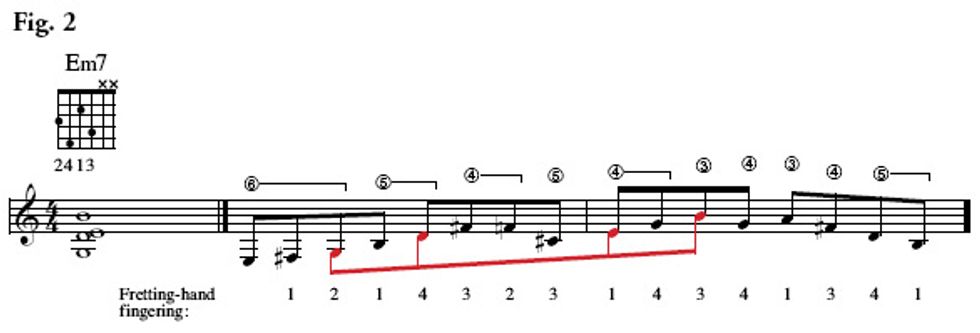
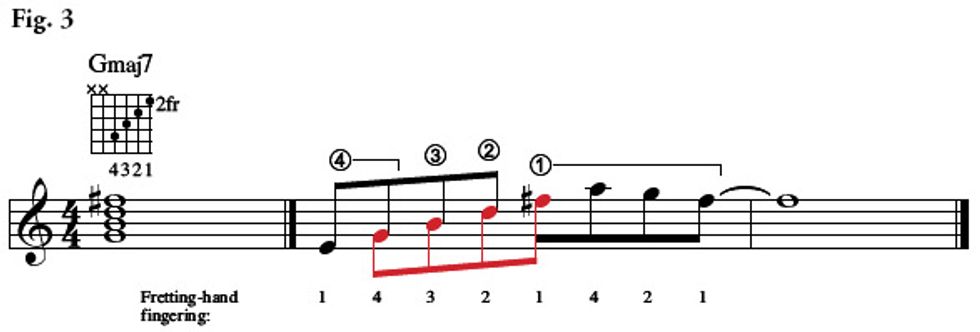
When combined with fluency, these dual patterns become unified as one, and although constructed from vertical tangents, they now appear horizontal in context, as seen in Fig. 4. In this example, we first encounter the vertical Em11 (created by combining Em7 and Gmaj7), followed by a horizontal expression of this harmony.
Download Example Audio...
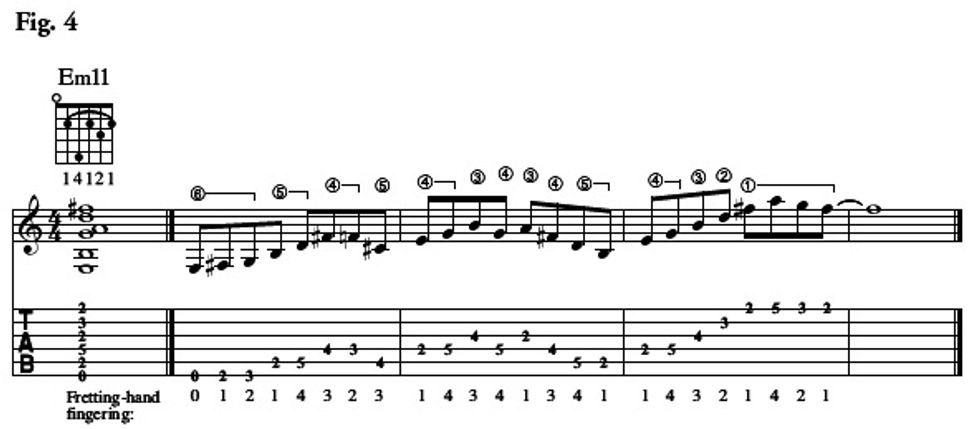
Keep in mind that forms of this nature are commonly transcribed and analyzed as derivatives of scale and modal concepts, but in reality, they were not constructed in those ways. As we saw in last month’s lesson (“Augmented and Diminished Forms,” March 2011 PG), augmented and diminished structures, as parental forms, automatically position themselves across the guitar fretboard. They appear both vertically and horizontally, along with their alterations that produce dominant 7th, major 7th, and minor 7th forms.
Once you explore these shapes you can also see their related inversions develop exponentially across the fretboard, not only as chordal inversions, but as arpeggio-based linear inversions as well. We’ll continue to unfold these expansions in our upcoming lessons.
 Pat Martino
Pat MartinoSince his first recording as a leader in 1967, Pat Martino has constantly pushed the limits of jazz guitar with his flowing technique and powerful, muscular tone. Showing no signs of slowing down, Martino still travels the world performing and giving lectures about his approach to the guitar. Currently, Martino is working on an autobiography and serving as adjunct faculty at the University of the Arts in Philadelphia. For more info, visit patmartino.com.




